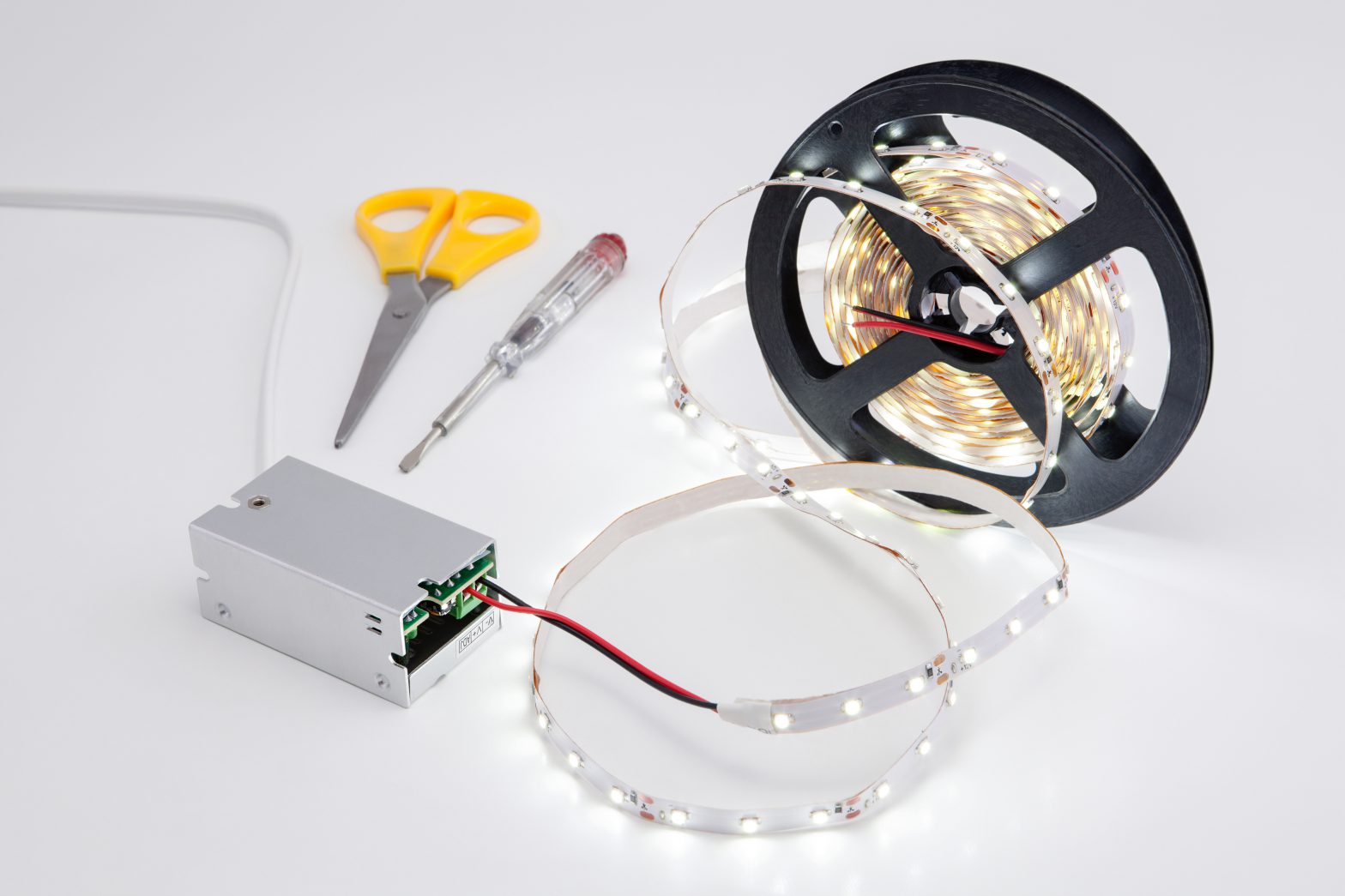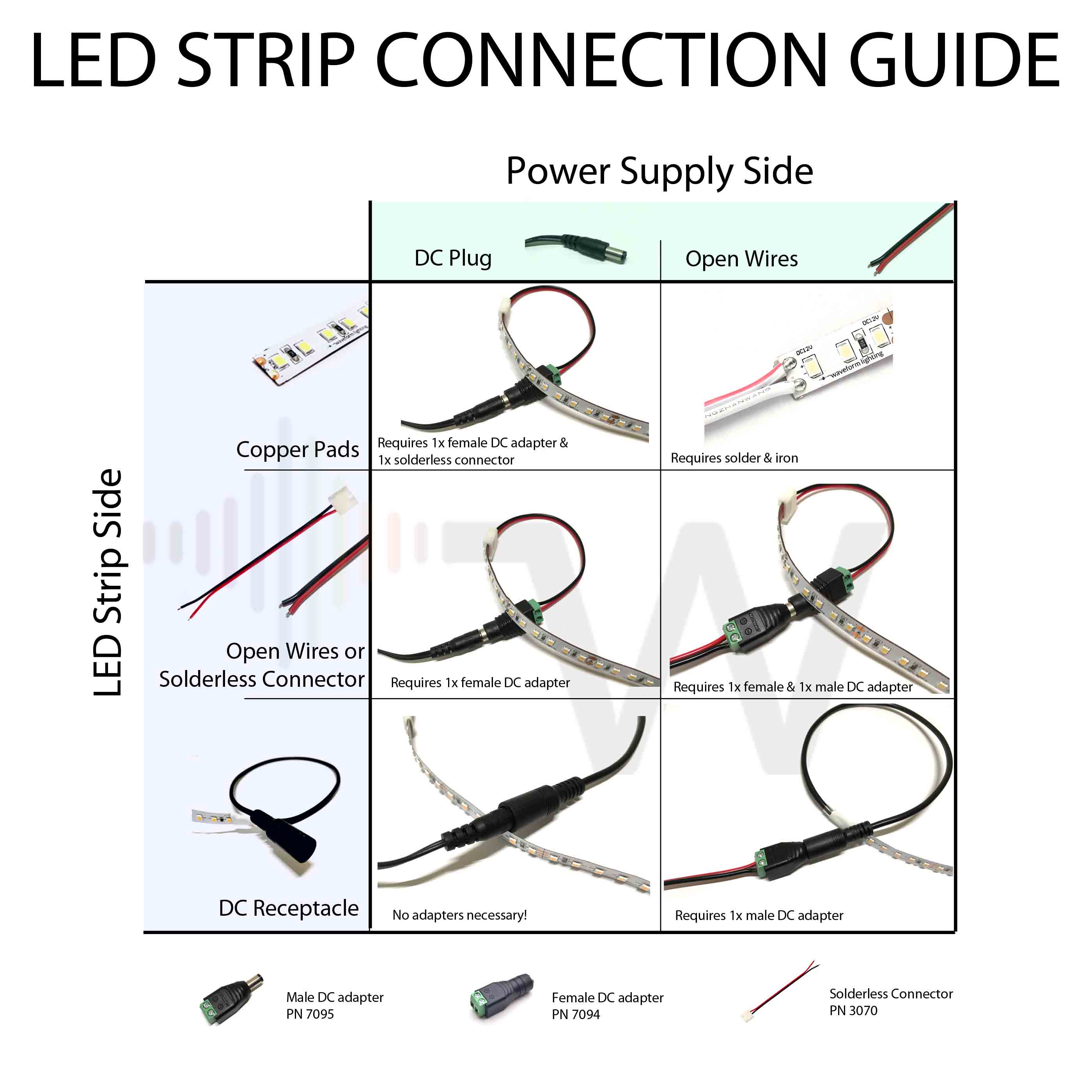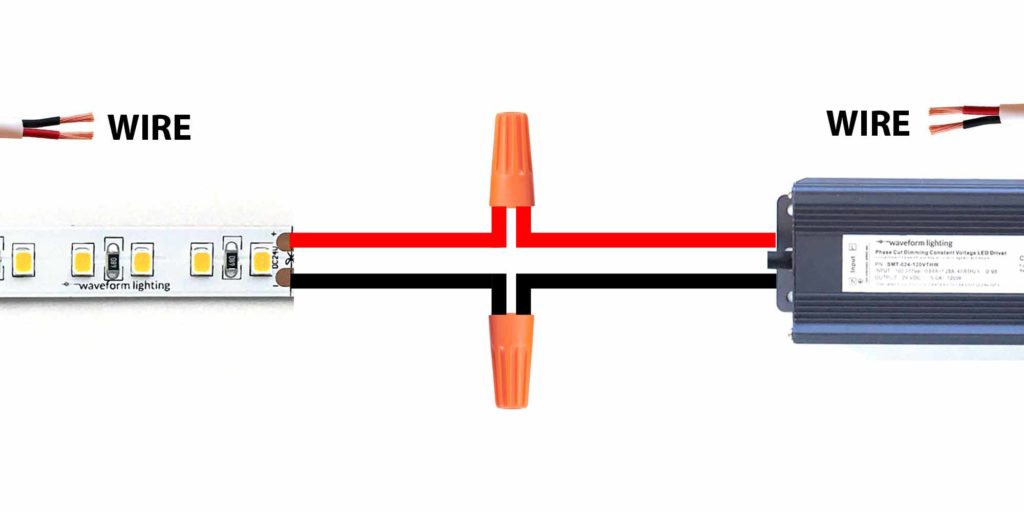
How to Connect An LED Strip to a Power Supply
If you're new to LED strip lights but are eager to get them up and running, the most critical step is figuring out how to provide the appropriate power input to the LED strip in order to get it to light up. Depending on where you purchased your LED strip and LED power supply, set up methods may differ. Below, we'll go over the most common setups.
Ensure Electrical Compatibility of the LED Strip and Power Supply
Most LED strip light products operate on low voltage DC. Common DC voltages used are 12V and 24V.
First and foremost, check that the power supply is rated for the correct voltage that matches the LED strip voltage. Undervoltage to the LED strip will result in the LED strip operating at lower brightness or no light output at all, and overvoltage will burn out your LEDs.
Secondly, make sure that the power supply capacity is sufficient for the length of LED strip being used. This can be calculated by looking at the LED strip's specifications sheet, which typically lists the current or power draw per length.
If both of these conditions are met, electrically speaking, we are good to go.
Waveform Lighting's LED Strip Connection Guide Chart
Next, we'll need to look at whether the power supply and LED strip are physically compatible in the way of connectors and plugs. Because LED strips and power supplies come in a variety of connection types, it can get a bit confusing. So, to help shed some light (pun intended!) we've put together the chart below.
Click here for a downloadable PDF version which may help if you are having trouble with the text size.

How to interpret this chart:
First, determine the type of connection used on the "Power Supply Side" (shaded green). Then, determine the type of connection used on the "LED Strip Side" (shaded blue). Detailed instructions for determining the type are below.
Next, find the intersection of the row and column that applies to your setup. For example, if you have "Open Wires" on your power supply and "DC Receptacles" on your LED strip, reference the bottom right square in the chart.
The photo and text inside the square describe how the connection is achieved, along with the accessories and components that you will need. See below for additional detail:

Determining the Power Supply's DC Output Connector (Shaded Green)
We start by looking at the power supply's connector type on the DC output side.
The most common connector is a DC male plug, such as what is used in Waveform Lighting FilmGrade power supplies:
In other cases, such as with Meanwell power supplies, there may be no plug at all - just two wires marked in red and white:
Both types can be made to work with an LED strip, but the connection methodology will be different, so be sure to determine this prior to moving forward.
Next, check the connection type on the LED strip (shaded blue)
Almost all LED strips have copper pads, labeled (+) and (-) on the actual strip itself. This is where the electrical inputs must ultimately be fed through. Depending on your particular situation, you will likely encounter three different possible scenarios.
In the first scenario (first row of chart), if you've cut up any segments of an LED strip reel, you will find that at the end of each segment remain (roughly) half-circular copper pads.
If you've purchased an entire reel, the manufacturer has likely provided some wires already mounted onto the ends of the LED strip. The wires can either be open leads with exposed wire (second scenario), or terminate with a DC receptacle (third scenario). If you do cut the LED strip into shorter segments, you will end up with at least one segment that falls under the first scenario.
Reference the chart above to determine how to connect each of these scenarios to the power supply.
Keep in mind some basic electronics principles: the end goal is to connect the positive wire (usually red) of the power supply's DC output to the (+) copper pad, and the negative or ground (usually black or white) of the power supply's DC output to the (-) copper pad.
Converting Copper Pads to Wires
If you're cutting the LED strip into shorter segments, you will very likely end up with copper pads without any wires. Many tutorials and instructional videos will immediately suggest soldering wires onto those copper pads to achieve an electrical connection. But, soldering is not for everyone. It can be messy and requires some practice to do well.
Instead, we recommend using solderless connectors. These connectors are designed to clip onto the ends of the LED strip so that the wires make secure contact with the copper pads. Because the clips attach securely, no solder is needed.
Just like this, in a matter of seconds, you can convert copper pads on the end of an LED strip segment into wires.
And, best of all, you can simply undo the latch to release and remove the LED strip from the connector.
(We also have solderless connectors to connect two LED strip segments.)
Should LED strip sections be connected in "parallel" or "series"?
If you're trying to connect more than one LED strip segment to a single power supply, you may suddenly realize that you could connect the first segment to the second segment in "series" or connect to two segments independently to the same power supply.
Generally, "series" will be more straightforward, but may lead to some issues with voltage drop. See here for an in-depth analysis of the advantages and disadvantages of each approach.
Where do I purchase the accessories to connect my LED strips to my power supply?
We offer the accessories for sale directly on our store. See below for links.
Purchase PN 7095 (Male DC Adapter)
Purchase PN 7094 (Female AC Adapter)
Purchase PN 3070 Solderless Connector
Ensure Electrical Compatibility of the LED Strip and Power Supply
Most LED strip light products operate on low voltage DC. Common DC voltages used are 12V and 24V.
First and foremost, check that the power supply is rated for the correct voltage that matches the LED strip voltage. Undervoltage to the LED strip will result in the LED strip operating at lower brightness or no light output at all, and overvoltage will burn out your LEDs.
Secondly, make sure that the power supply capacity is sufficient for the length of LED strip being used. This can be calculated by looking at the LED strip's specifications sheet, which typically lists the current or power draw per length.
If both of these conditions are met, electrically speaking, we are good to go.
Waveform Lighting's LED Strip Connection Guide Chart
Next, we'll need to look at whether the power supply and LED strip are physically compatible in the way of connectors and plugs. Because LED strips and power supplies come in a variety of connection types, it can get a bit confusing. So, to help shed some light (pun intended!) we've put together the chart below.
Click here for a downloadable PDF version which may help if you are having trouble with the text size.

How to interpret this chart:
First, determine the type of connection used on the "Power Supply Side" (shaded green). Then, determine the type of connection used on the "LED Strip Side" (shaded blue). Detailed instructions for determining the type are below.
Next, find the intersection of the row and column that applies to your setup. For example, if you have "Open Wires" on your power supply and "DC Receptacles" on your LED strip, reference the bottom right square in the chart.
The photo and text inside the square describe how the connection is achieved, along with the accessories and components that you will need. See below for additional detail:

Determining the Power Supply's DC Output Connector (Shaded Green)
We start by looking at the power supply's connector type on the DC output side.
The most common connector is a DC male plug, such as what is used in Waveform Lighting FilmGrade power supplies:
In other cases, such as with Meanwell power supplies, there may be no plug at all - just two wires marked in red and white:
Both types can be made to work with an LED strip, but the connection methodology will be different, so be sure to determine this prior to moving forward.
Next, check the connection type on the LED strip (shaded blue)
Almost all LED strips have copper pads, labeled (+) and (-) on the actual strip itself. This is where the electrical inputs must ultimately be fed through. Depending on your particular situation, you will likely encounter three different possible scenarios.
In the first scenario (first row of chart), if you've cut up any segments of an LED strip reel, you will find that at the end of each segment remain (roughly) half-circular copper pads.
If you've purchased an entire reel, the manufacturer has likely provided some wires already mounted onto the ends of the LED strip. The wires can either be open leads with exposed wire (second scenario), or terminate with a DC receptacle (third scenario). If you do cut the LED strip into shorter segments, you will end up with at least one segment that falls under the first scenario.
Reference the chart above to determine how to connect each of these scenarios to the power supply.
Keep in mind some basic electronics principles: the end goal is to connect the positive wire (usually red) of the power supply's DC output to the (+) copper pad, and the negative or ground (usually black or white) of the power supply's DC output to the (-) copper pad.
Converting Copper Pads to Wires
If you're cutting the LED strip into shorter segments, you will very likely end up with copper pads without any wires. Many tutorials and instructional videos will immediately suggest soldering wires onto those copper pads to achieve an electrical connection. But, soldering is not for everyone. It can be messy and requires some practice to do well.
Instead, we recommend using solderless connectors. These connectors are designed to clip onto the ends of the LED strip so that the wires make secure contact with the copper pads. Because the clips attach securely, no solder is needed.
Just like this, in a matter of seconds, you can convert copper pads on the end of an LED strip segment into wires.
And, best of all, you can simply undo the latch to release and remove the LED strip from the connector.
(We also have solderless connectors to connect two LED strip segments.)
Should LED strip sections be connected in "parallel" or "series"?
If you're trying to connect more than one LED strip segment to a single power supply, you may suddenly realize that you could connect the first segment to the second segment in "series" or connect to two segments independently to the same power supply.
Generally, "series" will be more straightforward, but may lead to some issues with voltage drop. See here for an in-depth analysis of the advantages and disadvantages of each approach.
Where do I purchase the accessories to connect my LED strips to my power supply?
We offer the accessories for sale directly on our store. See below for links.
Purchase PN 7095 (Male DC Adapter)
Purchase PN 7094 (Female AC Adapter)
Purchase PN 3070 Solderless Connector
Other Posts
Browse Waveform Lighting Products
A-Series LED Bulbs
Our A19 and A21 lamps fit in standard lamp fixtures and are perfect for floor and desk lamp fixtures.
Candelabra LED Bulbs
Our candelabra LED bulbs offer soft and warm light output in a decorative bulb style that fits E12 lamp fixtures.
BR30 LED Lamps
BR30 lamps are ceiling lamps that fit in residential and commercial fixtures with 4-inch or wider openings.
